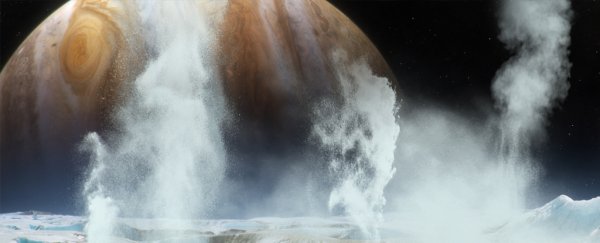A team led by researchers out of NASA's Goddard Space Flight Center in Greenbelt, Maryland, has confirmed traces of water vapor above the surface of Jupiter's icy moon Europa.
And that's a big deal as the tiny space rock is one of the highest priority targets in NASA's search for extraterrestrial life, according to the agency.
"While scientists have not yet detected liquid water directly, we've found the next best thing: water in vapor form," lead researcher and NASA planetary scientist Lucas Paganini said in a NASA statement.
According to a paper published in the journal Nature Astronomy on Monday, the NASA team discovered enough water vapor being released from Europa to fill an Olympic-size swimming pool within minutes.
But while that sounds like a lot, it was only just enough to be detected from Earth.
Out of 17 observations by the W. M. Keck Observatory in Hawaii, which uses a spectrograph to detect the chemical compositions of other planets' atmospheres by scanning the infrared light they release or absorb, the scientists only spotted water vapor in one.
"We suggest that the outgassing of water vapour on Europa occurs at lower levels than previously estimated, with only rare localized events of stronger activity," Paganini and his team wrote in the paper.
For many years, scientists have suspected that there's water on Europa's surface, and several observations appear to back up that suspicion.
More than two decades ago, NASA's Galileo spacecraft found evidence of an electrically conductive fluid on the moon's surface. Then, a 2018 analysis of the data found evidence of massive plumes of liquid. Data previously collected by NASA's Hubble Space Telescope supported the existence of the plumes.
"We performed diligent safety checks to remove possible contaminants in ground-based observations," Goddard planetary scientist Avi Mandell said of the water vapor discovery in the statement. "But, eventually, we'll have to get closer to Europa to see what's really going on."
A mission to do just that is already lined up.
NASA's upcoming Europa Clipper mission will get a much closer look at the icy moon's surface as soon as 2023.
The spacecraft will feature a suite of cameras, spectrometers, and a radar to investigate the thickness of Europa's icy shell during 45 flybys — and perhaps yield further insights into the water vapor above the moon's surface while it's there.
This article was originally published by Futurism. Read the original article.
